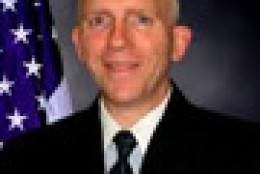On DoD
-
A former civilian employee at Sierra Army Depot faces a two-count charge for conspiracy and theft of military equipment.
July 11, 2014 -
The Navy thinks 3D printing can eliminate a wide range of challenges with its supply chain. The service is already testing the idea of using additive manufacturing technologies to build small spare parts aboard ships, as they're needed, rather than having to transport them from supply ships or distant warehouses. And one day, the service thinks the technology could even be able to build a small UAV at the press of a button. Carolyn Lambeth is a mechanical engineer for Combat Direction Systems Activity at Dam Neck, Virginia. She explained the future of 3D printing at the Navy on In Depth with Francis Rose.
July 10, 2014 -
The technical name for one of the Army's communications networks is Warfighter Information Network-Tactical Increment Two. But some soldiers prefer to call it their digital guardian angel. Another calls it the holy grail of communication. Now one of the creators of the Army's WIN-T system is receiving prestigious recognition for his role in its creation. Patrick DeGroodt is Deputy Project Manager for the Department of the Army. He's a Service to America medal finalist in the National Security and International Affairs category. He explained the creation process on In Depth with Francis Rose. Read a Q&A with DeGroodt.
July 09, 2014 -
A new bipartisan report from the Senate's Permanent Subcommittee on Investigations called the Air Force's now-canceled Expeditionary Combat Support System "one of the most egregious examples of mismanagement by the DoD in recent memory." But the failure of ECSS may not be an aberration, the report suggested. Other enterprise-resource planning programs in the department are at risk of falling victim to the same fate.
July 09, 2014 -
Sean C. Young and Benjamin J. Tran, two electronics engineers with the Air Force Research Lab created an aerial sensor that has helped U.S. service members to find and destroy dangerous improvised explosive devices (IEDs) in Afghanistan.
July 07, 2014 -
The Service to America Medals honor federal employees who go above and beyond their job descriptions to serve the public. For the next few months, Federal News Radio will be speaking to the finalists. A civilian engineer is reshaping the way the military performs operations in the air and on the field. Sean Young is an electronics engineer with the Air Force Research Laboratory in Ohio. He helped save soldiers' lives in Afghanistan by creating a new aerial sensor system to detect improvised explosive devices. For his creativity, he is a finalist in the National Security and International Affairs category of the 2014 Sammies awards. He joined Tom Temin on the Federal Drive to talk about his nomination. View a gallery of all the Sammies nominees. Read a Q&A with Sean Young.
July 07, 2014 -
Among ten topics the Army's new undersecretary says he's pondering: the service's seeming inability to convince policymakers of the need to keep a standing active duty force of about the size the nation has today, even during budget cuts.
July 07, 2014 -
One of the creators of a new mobile communications network for the Army is earning some lofty recognition. The system's technical name is the Warfighter Information Network-Tactical, Increment Two, or WIN-T. Some soldiers call it their digital guardian angel. It's offers brigades in Afghanistan a digital network that can move voice, video and data in almost any environment. Patrick Degroodt is Deputy Product Manager for the WIN-T program and now a finalist for a Service to America medal in the National Security and International Affairs category.
July 03, 2014 -
The Navy has its first female four-star admiral, Michelle Janine Howard. She was promoted on Tuesday to the service's highest rank. She graduated from the U.S. Naval Academy in 1982 and in 1999 became the first African-American woman to command a Navy ship. She was a key figure is the real-life rescue of Captain Richard Phillips from Somalia pirate. The story later became a block-buster movie.
July 03, 2014 -
A new approach to defense acquisition reform may come from a television show. Nick Guertin, director of transformation in the Office of the Deputy Assistant Secretary of the Navy for Research, Development, Test and Evaluation, and his colleague Howard Reichel, presented a paper called "Open Systems Architecture License Rights: A New Era for the Public-Private Marketplace" at the 11th annual Acquisition Research Symposium. Their views are their own. Nick tells Francis Rose on In Depth about the unique challenge intellectual property poses for defense contracting.
July 02, 2014 -
The Defense Department is shaking up the $380 billion F-35 Joint Strike Fighter program. Yesterday, Lt. Gen. Christopher Bodgan, the program director, explained how the Pentagon was asking major contractors to put skin in the game and invest in cost-reduction measures. In the second part of his interview with Tom Temin and Emily Kopp on the Federal Drive, Bogdan takes a long-term view on the Pentagon's sometimes rocky relationship with Lockheed Martin and other key players.
July 01, 2014 -
The Defense Department's request for its overseas contingency operations is about $20 billion less than initial estimates. Former Defense officials say realistic goals and managed expectations usually spelled success for weapons systems.
June 30, 2014 -
A Virginia government contractor is sentenced for conspiracy to bribe public officials.
June 27, 2014 -
Army Corps of Engineers faces billions of dollars in backlogged projects. With little hope of additional funding from Congress, officials are looking for alternative ways to finance the public infrastructure they're charged with maintaining.
June 27, 2014 -
Lt. Gen. Robert Ferrell, the Army's CIO/G6, said the service now is requiring all enterprise software titles to be modernized, virtualized and migrated to an approved data center.
June 26, 2014







